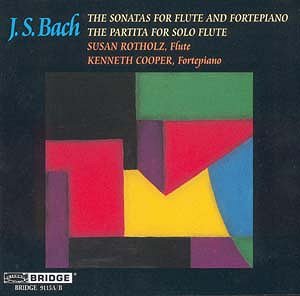Susan Rotholz and Kenneth Cooper
present a unique recording of Bachís flute sonatas, using a fortepiano
for accompaniment. The fortepiano is the earliest form of piano, and
Bach is believed to have at least played one if not actually owned one
himself. The sound of this instrument is much more restrained than that
of a modern piano, but it is indeed a piano, being hammered as opposed
to being plucked like a harpsichord.
When Cooper gets a chance to play
a few measures alone, the result is brilliant. The opening of the Siciliano
in sonata BWV 1031, and the solo sections later in this movement, are
bubbling over with energy. Unfortunately, the tone of the flute and
the recording itself tend to drown out the fortepiano. The flute is
too present and overpowers the fortepiano when they are playing together.
The liner notes speak of "perhaps
a new approach to historically informed music-making", but this
is only halfway true. While the choice of the fortepiano is indeed interesting
- and certainly more justified than using a modern piano - the use of
a modern flute gives this recording a sound that just doesnít work.
With a wooden flute, the sound would have been so much cozier, so much
warmer. But the cold sound of a metal flute with the rich fortepiano
just doesnít work.
The effect seems more pleasing in
the B minor sonata, BWV 1030, where the flute, at least in the opening
movement, is more hesitant, more interested in playing with the fortepiano,
not against it and over it. For that is the real problem with this disc
- it does not sound like the two instruments are truly playing together.
They seem at odds with each other, rather than being part of the same
music. But the closing movement of the same sonata is where the music
suddenly works - the rhythm is right, the energy present, and the two
instruments finally sound like they are working together. Cooperís brilliant
dynamics, coupled with some excellent phrasing by Rotholz, make this
movement a joy. A pity the rest of the set does not have this energy.
This is an interesting experiment,
and I would love to hear Kenneth Cooper play some more Bach on this
lovely instrument (there is no mention of its pedigree). While there
are some excellent moments in this set, the overall impression is not
very compelling.
Kirk
McElhearn
